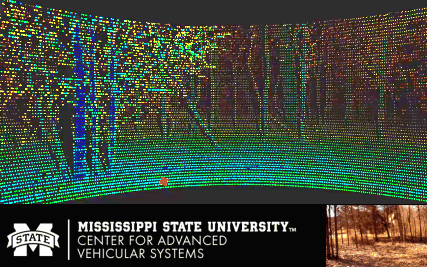University Research Center uses Ouster Lidar for Testing Autonomous Vehicles in Off-Road Environments
April 24, 2019
MSU Halo vehicle mapping the woods and off-road terrain with Ouster OS-1-64
The Center for Advanced Vehicular Systems is a multi-disciplinary automotive research center with over 300 researchers working on projects ranging from designing new steel alloys, to modeling airflow around rockets. The MSU Halo Project, named after the exotic cars automakers sell that create a “halo” effect on the brand, is a self-driving, all-electric supercar designed to showcase the team’s expertise in automotive engineering. “Within the Halo Project, our autonomous tech team is the largest group. They are dedicated to finding solutions for the 99% of the Earth that is not paved,” said CAVS Associate Director and HaloProject leader Matt Doude. There’s currently a lot of cool autonomous vehicle research focused on on-road use cases, but the team believes off-road environments are where autonomous technology can most exceed human abilities. In off-road environments, humans have to make imprecise judgments about traversability, whereas lidar can measure exact dimensions of obstacles and a vehicle dynamics model can determine whether the vehicle can clear a given log, hill, or hole with certainty.
MSU Halo has one of the only off-road autonomous vehicle proving grounds in the world, where they’ve been testing Ouster lidar. The team has three Ouster lidar units on their vehicle - one to scan the horizon for objects and potential obstacles, and two to map the terrain directly in front of the vehicle. The horizon scanning lidar on top of the vehicle feeds data into a neural network used to classify objects and generate a 3D occupancy grid. The other two lidar sensors are mounted on the front of the vehicle, tilted on two axes, to ensure that the beam paths are fairly normal to the ground and that all of the beams intersect the ground in front of the vehicle. Using the data from these three lidar sensors, the team can precisely model the terrain in front of the vehicle to complete traversability estimation.
The MSU Halo team is compiling the most comprehensive, detailed, multi-modal set of off-road autonomous vehicle data, and plans to open-source that data set on their website. They hope to spur mobility beyond urban centers to rural, undeveloped, and remote environments.
Stay tuned for more
Ouster is currently supporting many universities on their autonomous vehicle and robotics competitions through reduced pricing on sensors. We also can’t wait to share more university projects this year. If you are working in non-profit research, please reach out to us or for a mention on our blog.
